Contract Law: Validity and Enforceability
VerifiedAdded on 2023/01/03
|8
|2448
|47
AI Summary
This article discusses the validity and enforceability of contracts in relation to pre-registration contracts and assumptions made by outsiders. It also explores the relevant laws and case laws related to contract law.
Contribute Materials
Your contribution can guide someone’s learning journey. Share your
documents today.
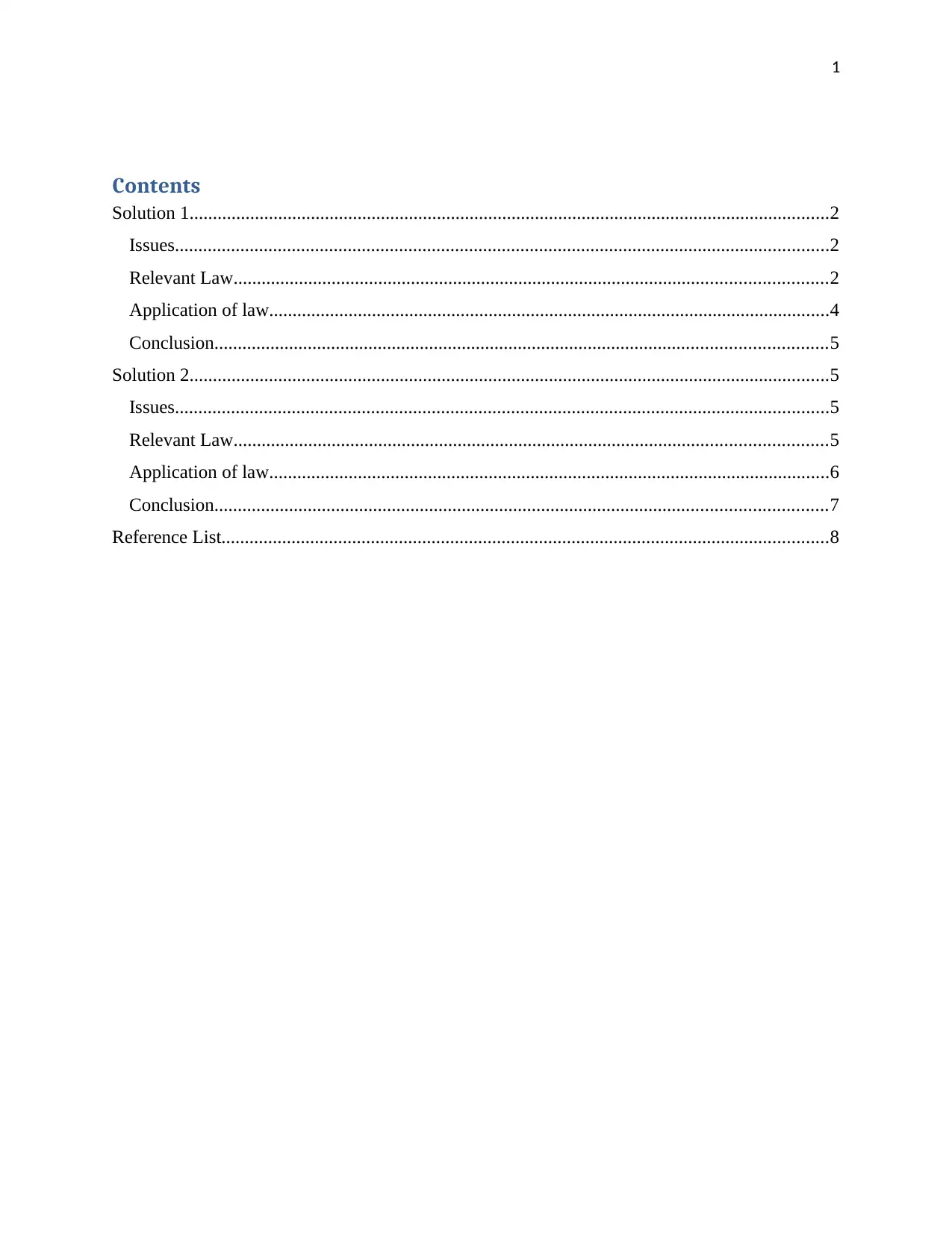
1
Contents
Solution 1.........................................................................................................................................2
Issues............................................................................................................................................2
Relevant Law...............................................................................................................................2
Application of law........................................................................................................................4
Conclusion...................................................................................................................................5
Solution 2.........................................................................................................................................5
Issues............................................................................................................................................5
Relevant Law...............................................................................................................................5
Application of law........................................................................................................................6
Conclusion...................................................................................................................................7
Reference List..................................................................................................................................8
Contents
Solution 1.........................................................................................................................................2
Issues............................................................................................................................................2
Relevant Law...............................................................................................................................2
Application of law........................................................................................................................4
Conclusion...................................................................................................................................5
Solution 2.........................................................................................................................................5
Issues............................................................................................................................................5
Relevant Law...............................................................................................................................5
Application of law........................................................................................................................6
Conclusion...................................................................................................................................7
Reference List..................................................................................................................................8
Secure Best Marks with AI Grader
Need help grading? Try our AI Grader for instant feedback on your assignments.
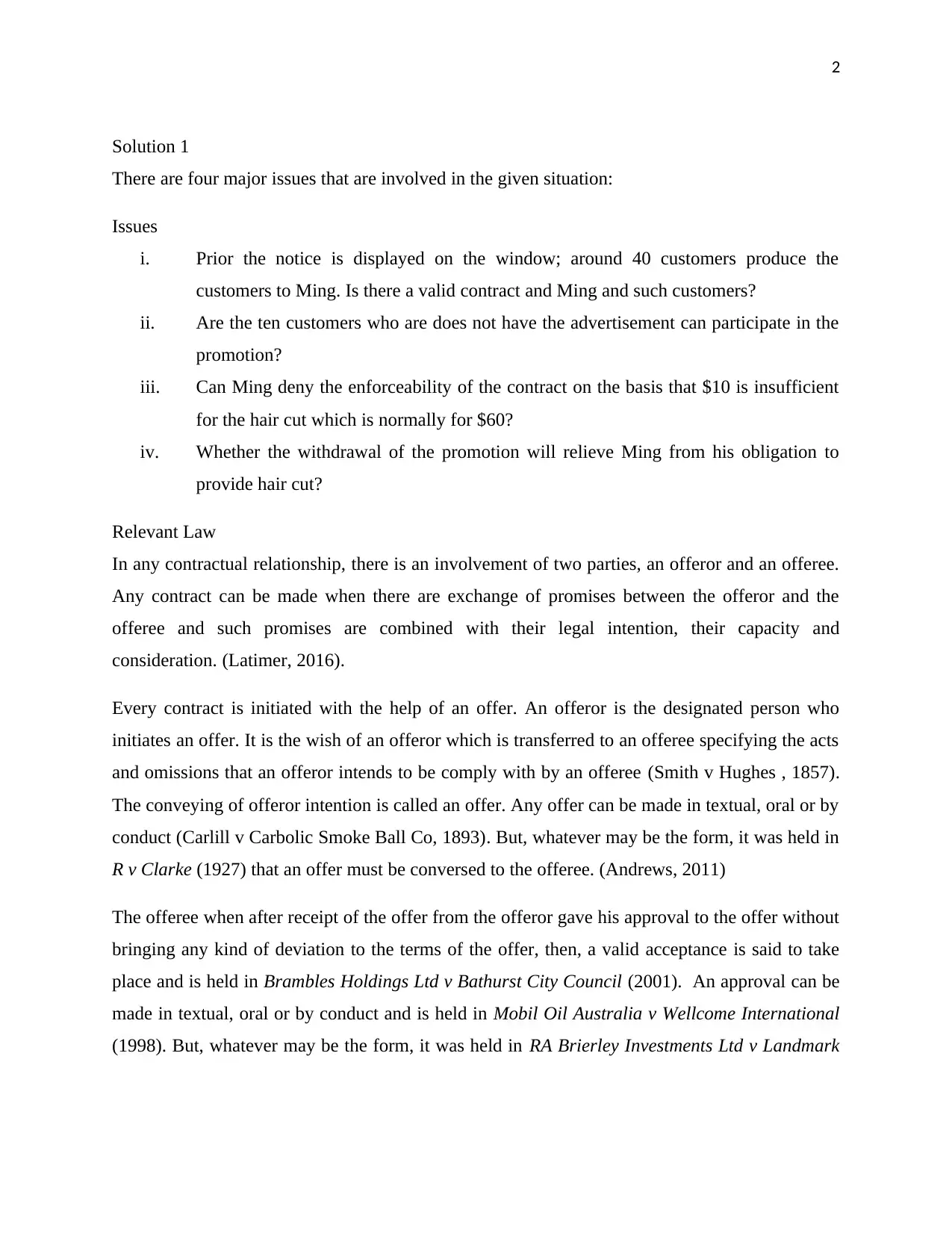
2
Solution 1
There are four major issues that are involved in the given situation:
Issues
i. Prior the notice is displayed on the window; around 40 customers produce the
customers to Ming. Is there a valid contract and Ming and such customers?
ii. Are the ten customers who are does not have the advertisement can participate in the
promotion?
iii. Can Ming deny the enforceability of the contract on the basis that $10 is insufficient
for the hair cut which is normally for $60?
iv. Whether the withdrawal of the promotion will relieve Ming from his obligation to
provide hair cut?
Relevant Law
In any contractual relationship, there is an involvement of two parties, an offeror and an offeree.
Any contract can be made when there are exchange of promises between the offeror and the
offeree and such promises are combined with their legal intention, their capacity and
consideration. (Latimer, 2016).
Every contract is initiated with the help of an offer. An offeror is the designated person who
initiates an offer. It is the wish of an offeror which is transferred to an offeree specifying the acts
and omissions that an offeror intends to be comply with by an offeree (Smith v Hughes , 1857).
The conveying of offeror intention is called an offer. Any offer can be made in textual, oral or by
conduct (Carlill v Carbolic Smoke Ball Co, 1893). But, whatever may be the form, it was held in
R v Clarke (1927) that an offer must be conversed to the offeree. (Andrews, 2011)
The offeree when after receipt of the offer from the offeror gave his approval to the offer without
bringing any kind of deviation to the terms of the offer, then, a valid acceptance is said to take
place and is held in Brambles Holdings Ltd v Bathurst City Council (2001). An approval can be
made in textual, oral or by conduct and is held in Mobil Oil Australia v Wellcome International
(1998). But, whatever may be the form, it was held in RA Brierley Investments Ltd v Landmark
Solution 1
There are four major issues that are involved in the given situation:
Issues
i. Prior the notice is displayed on the window; around 40 customers produce the
customers to Ming. Is there a valid contract and Ming and such customers?
ii. Are the ten customers who are does not have the advertisement can participate in the
promotion?
iii. Can Ming deny the enforceability of the contract on the basis that $10 is insufficient
for the hair cut which is normally for $60?
iv. Whether the withdrawal of the promotion will relieve Ming from his obligation to
provide hair cut?
Relevant Law
In any contractual relationship, there is an involvement of two parties, an offeror and an offeree.
Any contract can be made when there are exchange of promises between the offeror and the
offeree and such promises are combined with their legal intention, their capacity and
consideration. (Latimer, 2016).
Every contract is initiated with the help of an offer. An offeror is the designated person who
initiates an offer. It is the wish of an offeror which is transferred to an offeree specifying the acts
and omissions that an offeror intends to be comply with by an offeree (Smith v Hughes , 1857).
The conveying of offeror intention is called an offer. Any offer can be made in textual, oral or by
conduct (Carlill v Carbolic Smoke Ball Co, 1893). But, whatever may be the form, it was held in
R v Clarke (1927) that an offer must be conversed to the offeree. (Andrews, 2011)
The offeree when after receipt of the offer from the offeror gave his approval to the offer without
bringing any kind of deviation to the terms of the offer, then, a valid acceptance is said to take
place and is held in Brambles Holdings Ltd v Bathurst City Council (2001). An approval can be
made in textual, oral or by conduct and is held in Mobil Oil Australia v Wellcome International
(1998). But, whatever may be the form, it was held in RA Brierley Investments Ltd v Landmark
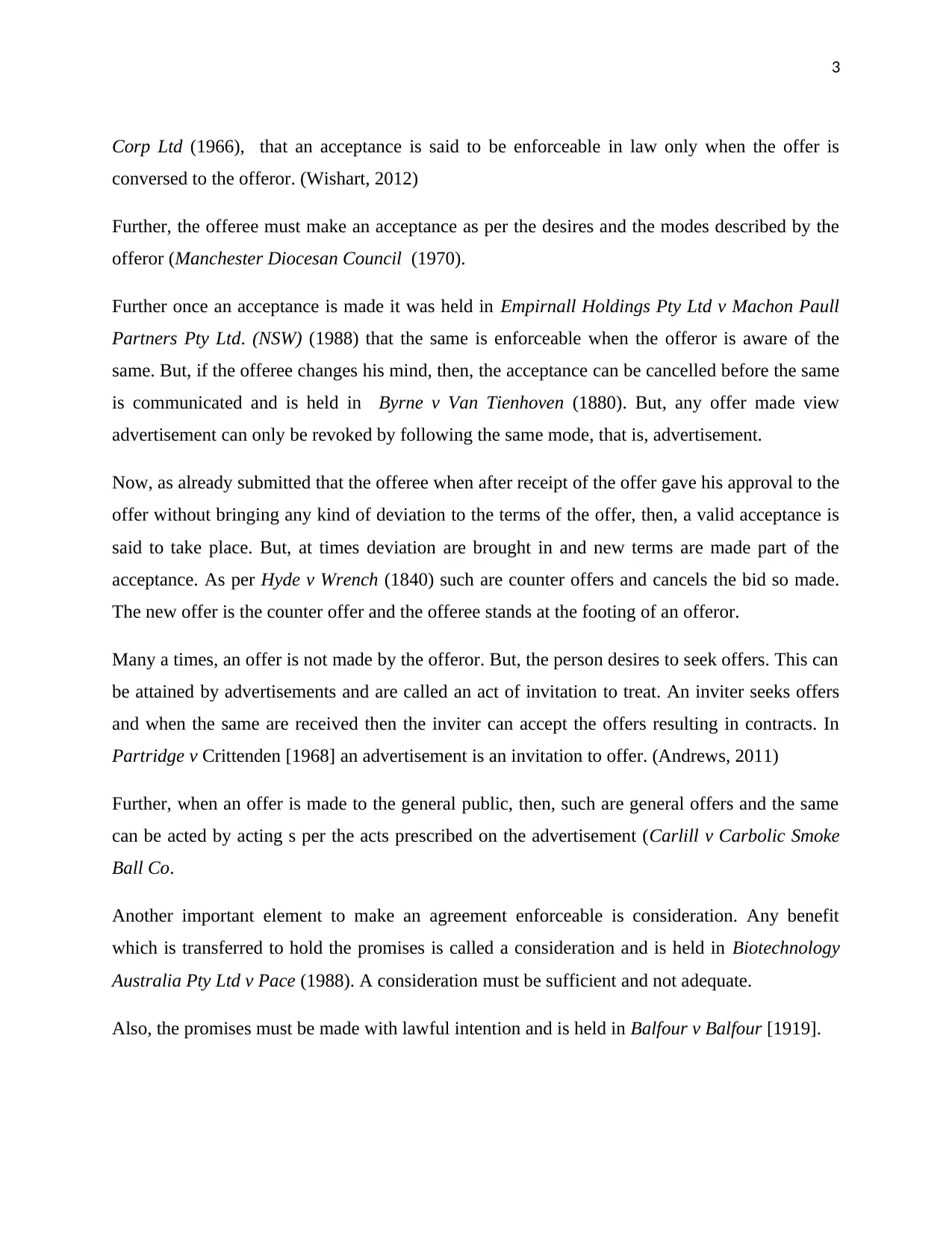
3
Corp Ltd (1966), that an acceptance is said to be enforceable in law only when the offer is
conversed to the offeror. (Wishart, 2012)
Further, the offeree must make an acceptance as per the desires and the modes described by the
offeror (Manchester Diocesan Council (1970).
Further once an acceptance is made it was held in Empirnall Holdings Pty Ltd v Machon Paull
Partners Pty Ltd. (NSW) (1988) that the same is enforceable when the offeror is aware of the
same. But, if the offeree changes his mind, then, the acceptance can be cancelled before the same
is communicated and is held in Byrne v Van Tienhoven (1880). But, any offer made view
advertisement can only be revoked by following the same mode, that is, advertisement.
Now, as already submitted that the offeree when after receipt of the offer gave his approval to the
offer without bringing any kind of deviation to the terms of the offer, then, a valid acceptance is
said to take place. But, at times deviation are brought in and new terms are made part of the
acceptance. As per Hyde v Wrench (1840) such are counter offers and cancels the bid so made.
The new offer is the counter offer and the offeree stands at the footing of an offeror.
Many a times, an offer is not made by the offeror. But, the person desires to seek offers. This can
be attained by advertisements and are called an act of invitation to treat. An inviter seeks offers
and when the same are received then the inviter can accept the offers resulting in contracts. In
Partridge v Crittenden [1968] an advertisement is an invitation to offer. (Andrews, 2011)
Further, when an offer is made to the general public, then, such are general offers and the same
can be acted by acting s per the acts prescribed on the advertisement (Carlill v Carbolic Smoke
Ball Co.
Another important element to make an agreement enforceable is consideration. Any benefit
which is transferred to hold the promises is called a consideration and is held in Biotechnology
Australia Pty Ltd v Pace (1988). A consideration must be sufficient and not adequate.
Also, the promises must be made with lawful intention and is held in Balfour v Balfour [1919].
Corp Ltd (1966), that an acceptance is said to be enforceable in law only when the offer is
conversed to the offeror. (Wishart, 2012)
Further, the offeree must make an acceptance as per the desires and the modes described by the
offeror (Manchester Diocesan Council (1970).
Further once an acceptance is made it was held in Empirnall Holdings Pty Ltd v Machon Paull
Partners Pty Ltd. (NSW) (1988) that the same is enforceable when the offeror is aware of the
same. But, if the offeree changes his mind, then, the acceptance can be cancelled before the same
is communicated and is held in Byrne v Van Tienhoven (1880). But, any offer made view
advertisement can only be revoked by following the same mode, that is, advertisement.
Now, as already submitted that the offeree when after receipt of the offer gave his approval to the
offer without bringing any kind of deviation to the terms of the offer, then, a valid acceptance is
said to take place. But, at times deviation are brought in and new terms are made part of the
acceptance. As per Hyde v Wrench (1840) such are counter offers and cancels the bid so made.
The new offer is the counter offer and the offeree stands at the footing of an offeror.
Many a times, an offer is not made by the offeror. But, the person desires to seek offers. This can
be attained by advertisements and are called an act of invitation to treat. An inviter seeks offers
and when the same are received then the inviter can accept the offers resulting in contracts. In
Partridge v Crittenden [1968] an advertisement is an invitation to offer. (Andrews, 2011)
Further, when an offer is made to the general public, then, such are general offers and the same
can be acted by acting s per the acts prescribed on the advertisement (Carlill v Carbolic Smoke
Ball Co.
Another important element to make an agreement enforceable is consideration. Any benefit
which is transferred to hold the promises is called a consideration and is held in Biotechnology
Australia Pty Ltd v Pace (1988). A consideration must be sufficient and not adequate.
Also, the promises must be made with lawful intention and is held in Balfour v Balfour [1919].
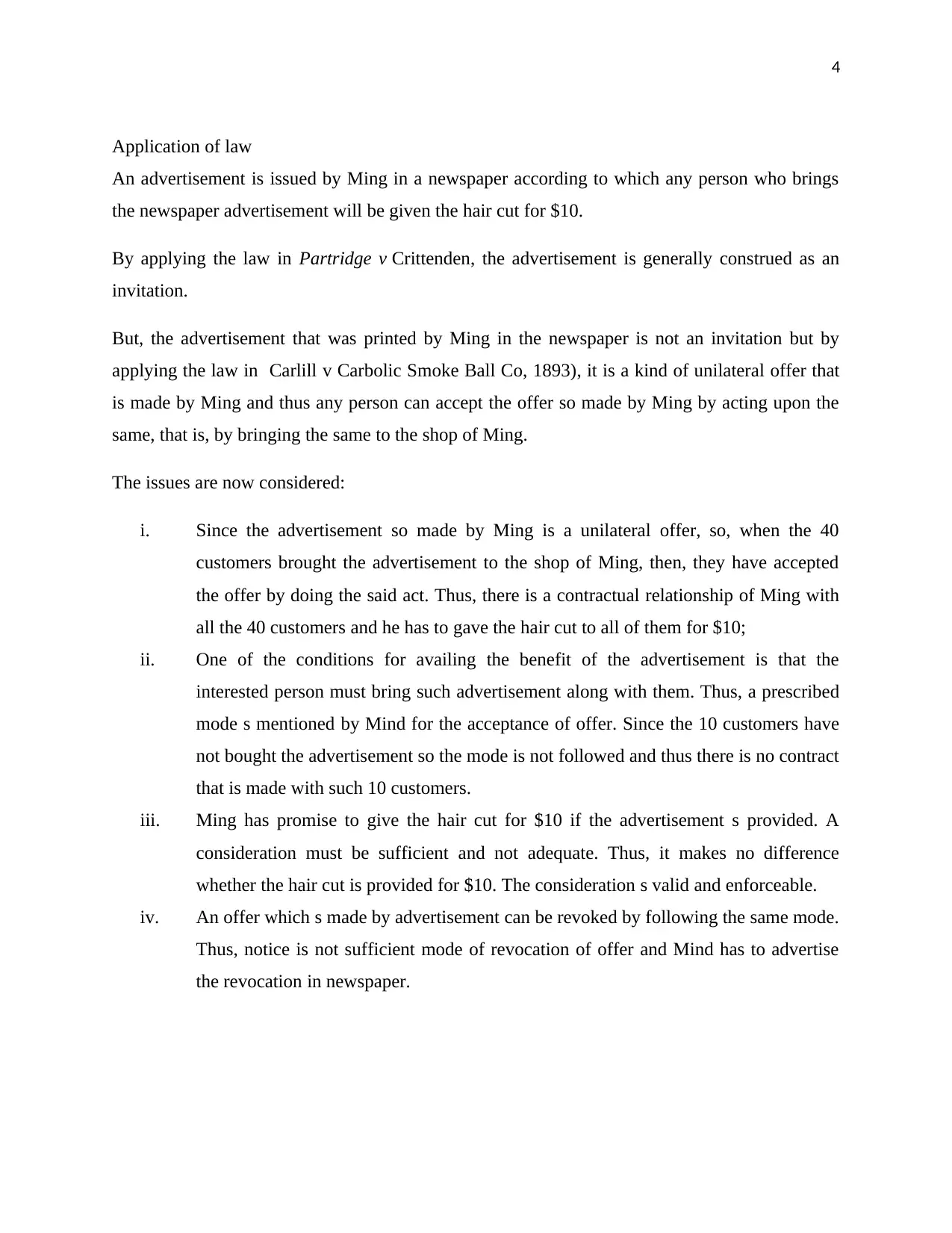
4
Application of law
An advertisement is issued by Ming in a newspaper according to which any person who brings
the newspaper advertisement will be given the hair cut for $10.
By applying the law in Partridge v Crittenden, the advertisement is generally construed as an
invitation.
But, the advertisement that was printed by Ming in the newspaper is not an invitation but by
applying the law in Carlill v Carbolic Smoke Ball Co, 1893), it is a kind of unilateral offer that
is made by Ming and thus any person can accept the offer so made by Ming by acting upon the
same, that is, by bringing the same to the shop of Ming.
The issues are now considered:
i. Since the advertisement so made by Ming is a unilateral offer, so, when the 40
customers brought the advertisement to the shop of Ming, then, they have accepted
the offer by doing the said act. Thus, there is a contractual relationship of Ming with
all the 40 customers and he has to gave the hair cut to all of them for $10;
ii. One of the conditions for availing the benefit of the advertisement is that the
interested person must bring such advertisement along with them. Thus, a prescribed
mode s mentioned by Mind for the acceptance of offer. Since the 10 customers have
not bought the advertisement so the mode is not followed and thus there is no contract
that is made with such 10 customers.
iii. Ming has promise to give the hair cut for $10 if the advertisement s provided. A
consideration must be sufficient and not adequate. Thus, it makes no difference
whether the hair cut is provided for $10. The consideration s valid and enforceable.
iv. An offer which s made by advertisement can be revoked by following the same mode.
Thus, notice is not sufficient mode of revocation of offer and Mind has to advertise
the revocation in newspaper.
Application of law
An advertisement is issued by Ming in a newspaper according to which any person who brings
the newspaper advertisement will be given the hair cut for $10.
By applying the law in Partridge v Crittenden, the advertisement is generally construed as an
invitation.
But, the advertisement that was printed by Ming in the newspaper is not an invitation but by
applying the law in Carlill v Carbolic Smoke Ball Co, 1893), it is a kind of unilateral offer that
is made by Ming and thus any person can accept the offer so made by Ming by acting upon the
same, that is, by bringing the same to the shop of Ming.
The issues are now considered:
i. Since the advertisement so made by Ming is a unilateral offer, so, when the 40
customers brought the advertisement to the shop of Ming, then, they have accepted
the offer by doing the said act. Thus, there is a contractual relationship of Ming with
all the 40 customers and he has to gave the hair cut to all of them for $10;
ii. One of the conditions for availing the benefit of the advertisement is that the
interested person must bring such advertisement along with them. Thus, a prescribed
mode s mentioned by Mind for the acceptance of offer. Since the 10 customers have
not bought the advertisement so the mode is not followed and thus there is no contract
that is made with such 10 customers.
iii. Ming has promise to give the hair cut for $10 if the advertisement s provided. A
consideration must be sufficient and not adequate. Thus, it makes no difference
whether the hair cut is provided for $10. The consideration s valid and enforceable.
iv. An offer which s made by advertisement can be revoked by following the same mode.
Thus, notice is not sufficient mode of revocation of offer and Mind has to advertise
the revocation in newspaper.
Secure Best Marks with AI Grader
Need help grading? Try our AI Grader for instant feedback on your assignments.
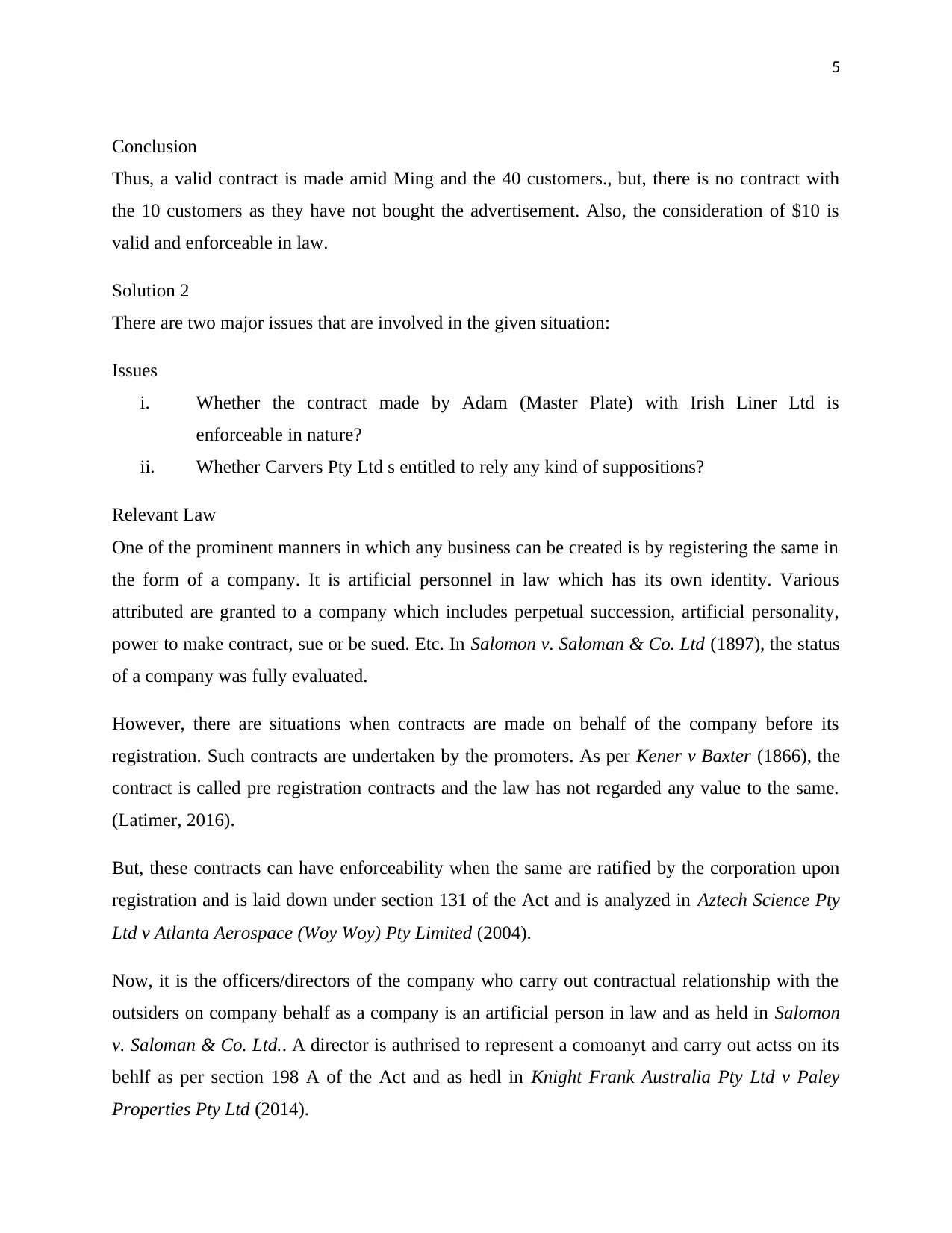
5
Conclusion
Thus, a valid contract is made amid Ming and the 40 customers., but, there is no contract with
the 10 customers as they have not bought the advertisement. Also, the consideration of $10 is
valid and enforceable in law.
Solution 2
There are two major issues that are involved in the given situation:
Issues
i. Whether the contract made by Adam (Master Plate) with Irish Liner Ltd is
enforceable in nature?
ii. Whether Carvers Pty Ltd s entitled to rely any kind of suppositions?
Relevant Law
One of the prominent manners in which any business can be created is by registering the same in
the form of a company. It is artificial personnel in law which has its own identity. Various
attributed are granted to a company which includes perpetual succession, artificial personality,
power to make contract, sue or be sued. Etc. In Salomon v. Saloman & Co. Ltd (1897), the status
of a company was fully evaluated.
However, there are situations when contracts are made on behalf of the company before its
registration. Such contracts are undertaken by the promoters. As per Kener v Baxter (1866), the
contract is called pre registration contracts and the law has not regarded any value to the same.
(Latimer, 2016).
But, these contracts can have enforceability when the same are ratified by the corporation upon
registration and is laid down under section 131 of the Act and is analyzed in Aztech Science Pty
Ltd v Atlanta Aerospace (Woy Woy) Pty Limited (2004).
Now, it is the officers/directors of the company who carry out contractual relationship with the
outsiders on company behalf as a company is an artificial person in law and as held in Salomon
v. Saloman & Co. Ltd.. A director is authrised to represent a comoanyt and carry out actss on its
behlf as per section 198 A of the Act and as hedl in Knight Frank Australia Pty Ltd v Paley
Properties Pty Ltd (2014).
Conclusion
Thus, a valid contract is made amid Ming and the 40 customers., but, there is no contract with
the 10 customers as they have not bought the advertisement. Also, the consideration of $10 is
valid and enforceable in law.
Solution 2
There are two major issues that are involved in the given situation:
Issues
i. Whether the contract made by Adam (Master Plate) with Irish Liner Ltd is
enforceable in nature?
ii. Whether Carvers Pty Ltd s entitled to rely any kind of suppositions?
Relevant Law
One of the prominent manners in which any business can be created is by registering the same in
the form of a company. It is artificial personnel in law which has its own identity. Various
attributed are granted to a company which includes perpetual succession, artificial personality,
power to make contract, sue or be sued. Etc. In Salomon v. Saloman & Co. Ltd (1897), the status
of a company was fully evaluated.
However, there are situations when contracts are made on behalf of the company before its
registration. Such contracts are undertaken by the promoters. As per Kener v Baxter (1866), the
contract is called pre registration contracts and the law has not regarded any value to the same.
(Latimer, 2016).
But, these contracts can have enforceability when the same are ratified by the corporation upon
registration and is laid down under section 131 of the Act and is analyzed in Aztech Science Pty
Ltd v Atlanta Aerospace (Woy Woy) Pty Limited (2004).
Now, it is the officers/directors of the company who carry out contractual relationship with the
outsiders on company behalf as a company is an artificial person in law and as held in Salomon
v. Saloman & Co. Ltd.. A director is authrised to represent a comoanyt and carry out actss on its
behlf as per section 198 A of the Act and as hedl in Knight Frank Australia Pty Ltd v Paley
Properties Pty Ltd (2014).
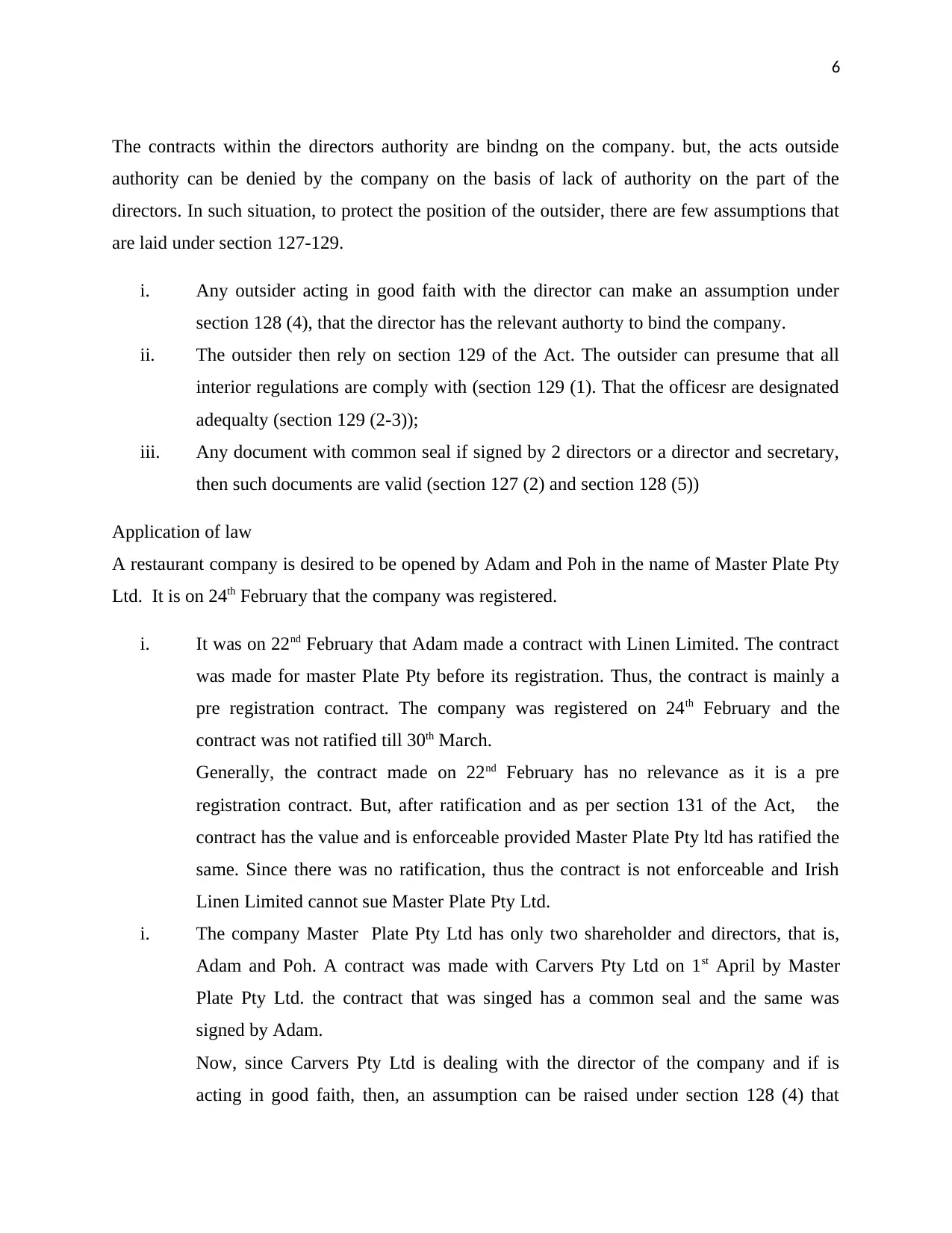
6
The contracts within the directors authority are bindng on the company. but, the acts outside
authority can be denied by the company on the basis of lack of authority on the part of the
directors. In such situation, to protect the position of the outsider, there are few assumptions that
are laid under section 127-129.
i. Any outsider acting in good faith with the director can make an assumption under
section 128 (4), that the director has the relevant authorty to bind the company.
ii. The outsider then rely on section 129 of the Act. The outsider can presume that all
interior regulations are comply with (section 129 (1). That the officesr are designated
adequalty (section 129 (2-3));
iii. Any document with common seal if signed by 2 directors or a director and secretary,
then such documents are valid (section 127 (2) and section 128 (5))
Application of law
A restaurant company is desired to be opened by Adam and Poh in the name of Master Plate Pty
Ltd. It is on 24th February that the company was registered.
i. It was on 22nd February that Adam made a contract with Linen Limited. The contract
was made for master Plate Pty before its registration. Thus, the contract is mainly a
pre registration contract. The company was registered on 24th February and the
contract was not ratified till 30th March.
Generally, the contract made on 22nd February has no relevance as it is a pre
registration contract. But, after ratification and as per section 131 of the Act, the
contract has the value and is enforceable provided Master Plate Pty ltd has ratified the
same. Since there was no ratification, thus the contract is not enforceable and Irish
Linen Limited cannot sue Master Plate Pty Ltd.
i. The company Master Plate Pty Ltd has only two shareholder and directors, that is,
Adam and Poh. A contract was made with Carvers Pty Ltd on 1st April by Master
Plate Pty Ltd. the contract that was singed has a common seal and the same was
signed by Adam.
Now, since Carvers Pty Ltd is dealing with the director of the company and if is
acting in good faith, then, an assumption can be raised under section 128 (4) that
The contracts within the directors authority are bindng on the company. but, the acts outside
authority can be denied by the company on the basis of lack of authority on the part of the
directors. In such situation, to protect the position of the outsider, there are few assumptions that
are laid under section 127-129.
i. Any outsider acting in good faith with the director can make an assumption under
section 128 (4), that the director has the relevant authorty to bind the company.
ii. The outsider then rely on section 129 of the Act. The outsider can presume that all
interior regulations are comply with (section 129 (1). That the officesr are designated
adequalty (section 129 (2-3));
iii. Any document with common seal if signed by 2 directors or a director and secretary,
then such documents are valid (section 127 (2) and section 128 (5))
Application of law
A restaurant company is desired to be opened by Adam and Poh in the name of Master Plate Pty
Ltd. It is on 24th February that the company was registered.
i. It was on 22nd February that Adam made a contract with Linen Limited. The contract
was made for master Plate Pty before its registration. Thus, the contract is mainly a
pre registration contract. The company was registered on 24th February and the
contract was not ratified till 30th March.
Generally, the contract made on 22nd February has no relevance as it is a pre
registration contract. But, after ratification and as per section 131 of the Act, the
contract has the value and is enforceable provided Master Plate Pty ltd has ratified the
same. Since there was no ratification, thus the contract is not enforceable and Irish
Linen Limited cannot sue Master Plate Pty Ltd.
i. The company Master Plate Pty Ltd has only two shareholder and directors, that is,
Adam and Poh. A contract was made with Carvers Pty Ltd on 1st April by Master
Plate Pty Ltd. the contract that was singed has a common seal and the same was
signed by Adam.
Now, since Carvers Pty Ltd is dealing with the director of the company and if is
acting in good faith, then, an assumption can be raised under section 128 (4) that
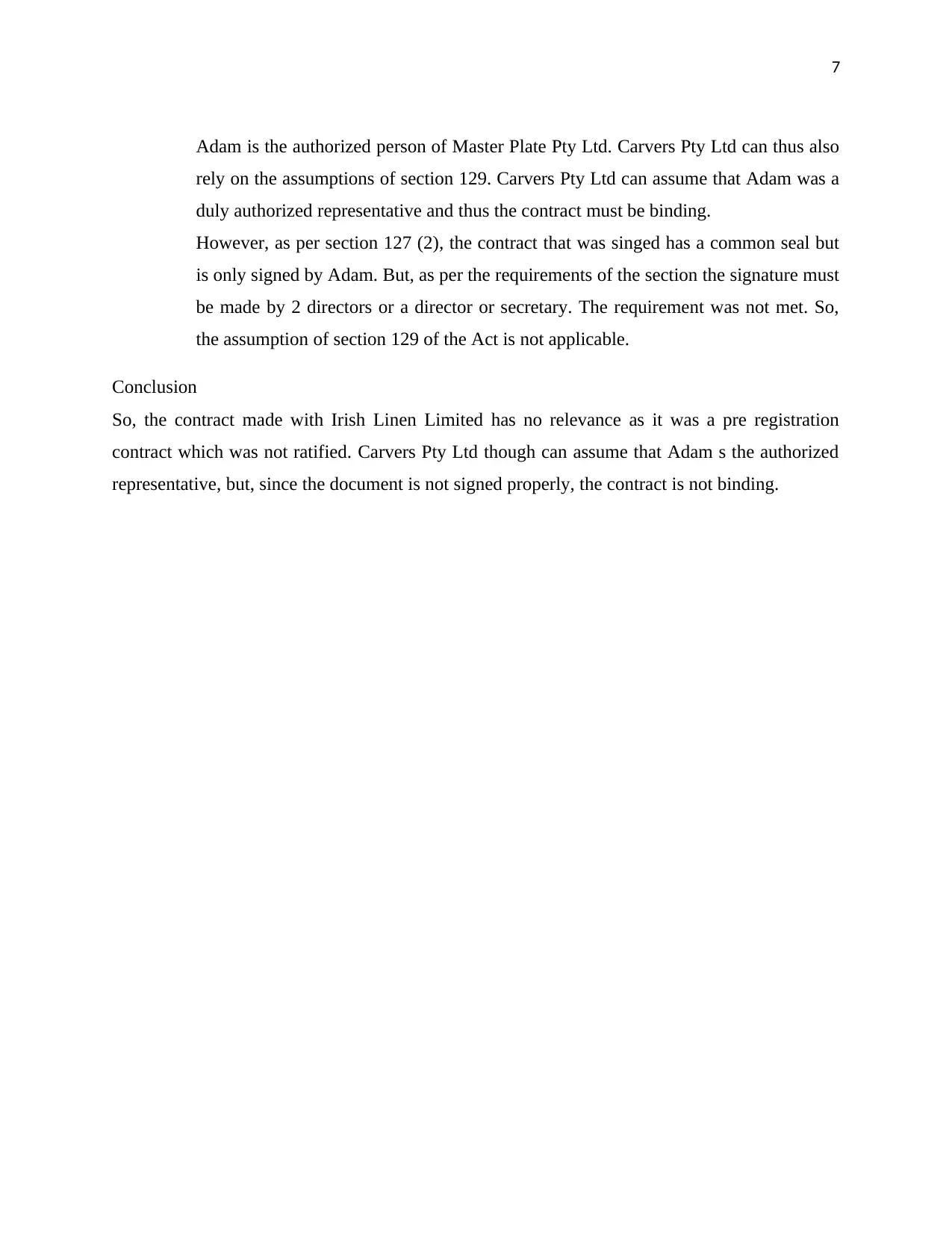
7
Adam is the authorized person of Master Plate Pty Ltd. Carvers Pty Ltd can thus also
rely on the assumptions of section 129. Carvers Pty Ltd can assume that Adam was a
duly authorized representative and thus the contract must be binding.
However, as per section 127 (2), the contract that was singed has a common seal but
is only signed by Adam. But, as per the requirements of the section the signature must
be made by 2 directors or a director or secretary. The requirement was not met. So,
the assumption of section 129 of the Act is not applicable.
Conclusion
So, the contract made with Irish Linen Limited has no relevance as it was a pre registration
contract which was not ratified. Carvers Pty Ltd though can assume that Adam s the authorized
representative, but, since the document is not signed properly, the contract is not binding.
Adam is the authorized person of Master Plate Pty Ltd. Carvers Pty Ltd can thus also
rely on the assumptions of section 129. Carvers Pty Ltd can assume that Adam was a
duly authorized representative and thus the contract must be binding.
However, as per section 127 (2), the contract that was singed has a common seal but
is only signed by Adam. But, as per the requirements of the section the signature must
be made by 2 directors or a director or secretary. The requirement was not met. So,
the assumption of section 129 of the Act is not applicable.
Conclusion
So, the contract made with Irish Linen Limited has no relevance as it was a pre registration
contract which was not ratified. Carvers Pty Ltd though can assume that Adam s the authorized
representative, but, since the document is not signed properly, the contract is not binding.
Paraphrase This Document
Need a fresh take? Get an instant paraphrase of this document with our AI Paraphraser
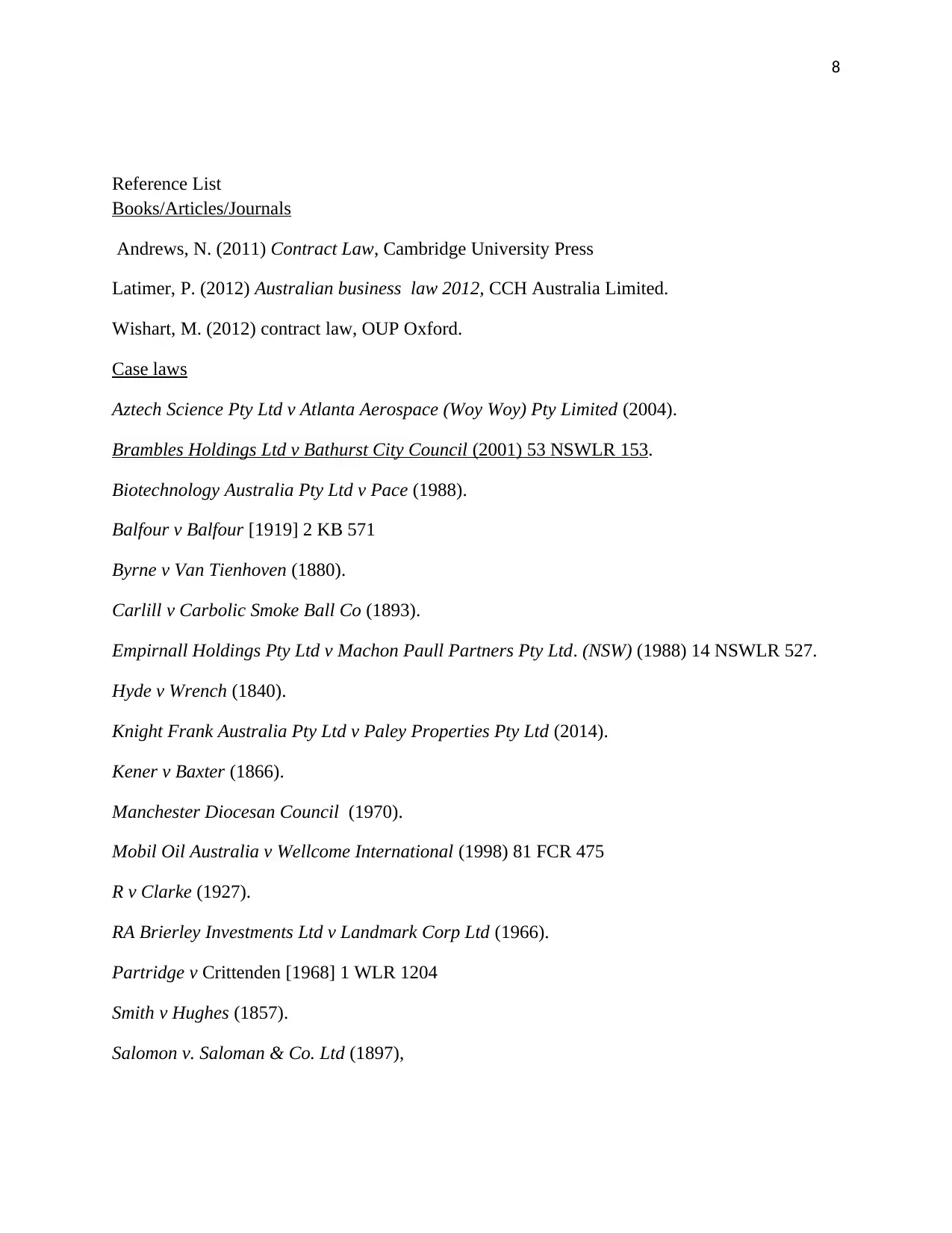
8
Reference List
Books/Articles/Journals
Andrews, N. (2011) Contract Law, Cambridge University Press
Latimer, P. (2012) Australian business law 2012, CCH Australia Limited.
Wishart, M. (2012) contract law, OUP Oxford.
Case laws
Aztech Science Pty Ltd v Atlanta Aerospace (Woy Woy) Pty Limited (2004).
Brambles Holdings Ltd v Bathurst City Council (2001) 53 NSWLR 153.
Biotechnology Australia Pty Ltd v Pace (1988).
Balfour v Balfour [1919] 2 KB 571
Byrne v Van Tienhoven (1880).
Carlill v Carbolic Smoke Ball Co (1893).
Empirnall Holdings Pty Ltd v Machon Paull Partners Pty Ltd. (NSW) (1988) 14 NSWLR 527.
Hyde v Wrench (1840).
Knight Frank Australia Pty Ltd v Paley Properties Pty Ltd (2014).
Kener v Baxter (1866).
Manchester Diocesan Council (1970).
Mobil Oil Australia v Wellcome International (1998) 81 FCR 475
R v Clarke (1927).
RA Brierley Investments Ltd v Landmark Corp Ltd (1966).
Partridge v Crittenden [1968] 1 WLR 1204
Smith v Hughes (1857).
Salomon v. Saloman & Co. Ltd (1897),
Reference List
Books/Articles/Journals
Andrews, N. (2011) Contract Law, Cambridge University Press
Latimer, P. (2012) Australian business law 2012, CCH Australia Limited.
Wishart, M. (2012) contract law, OUP Oxford.
Case laws
Aztech Science Pty Ltd v Atlanta Aerospace (Woy Woy) Pty Limited (2004).
Brambles Holdings Ltd v Bathurst City Council (2001) 53 NSWLR 153.
Biotechnology Australia Pty Ltd v Pace (1988).
Balfour v Balfour [1919] 2 KB 571
Byrne v Van Tienhoven (1880).
Carlill v Carbolic Smoke Ball Co (1893).
Empirnall Holdings Pty Ltd v Machon Paull Partners Pty Ltd. (NSW) (1988) 14 NSWLR 527.
Hyde v Wrench (1840).
Knight Frank Australia Pty Ltd v Paley Properties Pty Ltd (2014).
Kener v Baxter (1866).
Manchester Diocesan Council (1970).
Mobil Oil Australia v Wellcome International (1998) 81 FCR 475
R v Clarke (1927).
RA Brierley Investments Ltd v Landmark Corp Ltd (1966).
Partridge v Crittenden [1968] 1 WLR 1204
Smith v Hughes (1857).
Salomon v. Saloman & Co. Ltd (1897),
1 out of 8
Related Documents
Your All-in-One AI-Powered Toolkit for Academic Success.
+13062052269
info@desklib.com
Available 24*7 on WhatsApp / Email
![[object Object]](/_next/static/media/star-bottom.7253800d.svg)
Unlock your academic potential
© 2024 | Zucol Services PVT LTD | All rights reserved.



